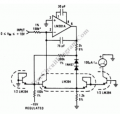I'm trying to design a analog square root sub circuit to process an input voltage and output sqrt(vin). I want to Use something other than a log and antilog amplifier with a voltage divider in between but I'm really struggling to design an alternative as I am still learning. I have tried a rigging together translinear based BJT circuits but really struggled with working with input currents and seeing expected voltage changes. I have proposed a new design using NPN BJTs and opamps to equate Vbe off effectively an attempt at a darling transistor against a regular log amp circuit. But I'm lost with the fact Vout would be a current sink and how to implement this is a wider circuit. I also don't know if this a passable implementation as I would really tack on another op amp to compensate the gain as shown in the photo. Please can someone give me direction on how to finish this circuit so I can sim and build it or advise me of my mistakes and lead me the correct direction as I'm really going round in circles with this one. 








